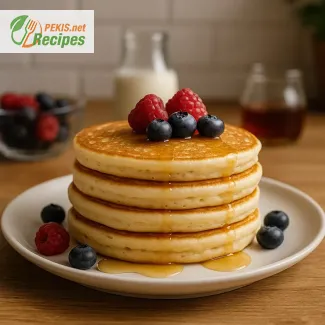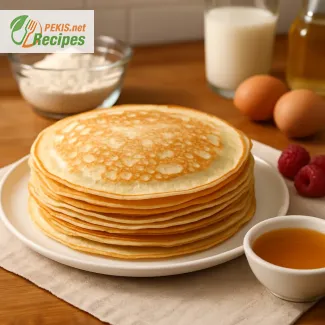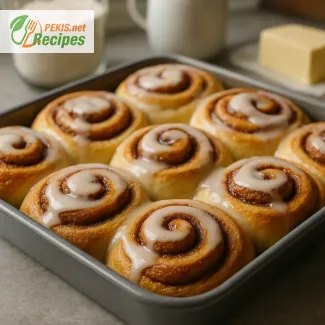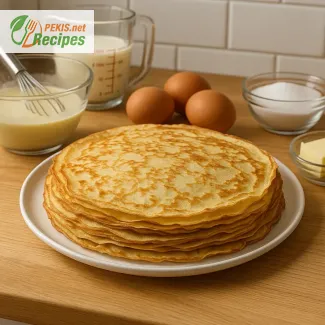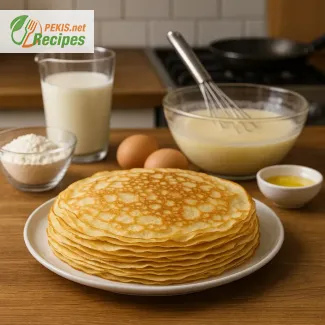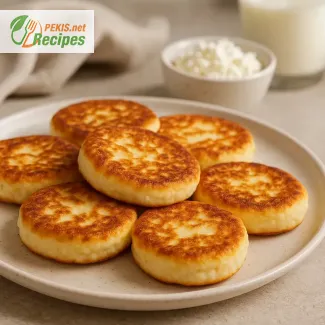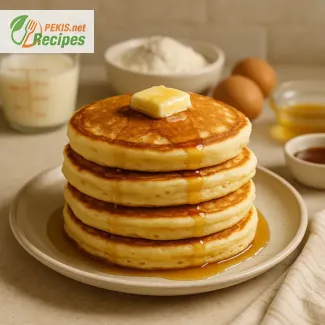
Fluffy Buttermilk Pancakes for the Perfect Morning Treat
Why buttermilk makes all the difference in traditional pancake recipes
When it comes to creating the ultimate fluffy pancake, few ingredients work magic quite like buttermilk. Known for its subtle tang and natural acidity, buttermilk does more than just enhance flavor—it also tenderizes and activates leavening agents, resulting in a cloud-like texture that defines a classic American pancake. Whether you're preparing breakfast for the family or hosting a weekend brunch, buttermilk pancakes deliver the comforting warmth and rich aroma that turn an ordinary morning into something memorable.
The science behind buttermilk and pancake fluffiness
It’s not just nostalgia that makes buttermilk a favorite in kitchens. Thanks to its acidity, it reacts with baking soda or baking powder to create gas bubbles that expand when heated, giving pancakes their signature lift. The result is a light, airy texture with just enough chew to hold up to toppings like syrup, butter, or fresh fruit. Unlike regular milk, buttermilk balances sweetness with a mild tang that deepens the flavor profile without overpowering it. This unique chemistry makes buttermilk indispensable for anyone seeking authentic, homemade pancakes that are soft on the inside and golden on the outside.
What sets buttermilk pancakes apart from other versions
Many pancake recipes use milk or yogurt, but they often fall short in texture and flavor. Buttermilk pancakes achieve that perfect balance between tenderness and structure. They hold their shape beautifully on the griddle while remaining soft enough to melt in your mouth. Their versatility makes them ideal for both sweet and savory variations. Whether served with maple syrup, seasonal berries, or a dollop of whipped cream, they elevate any breakfast plate.
Another major advantage? Buttermilk batter is forgiving. It tolerates slight overmixing better than regular milk batters and offers a smoother consistency for ladling onto a hot pan. This results in even browning, consistent rise, and a silky finish on each pancake surface.
Tips for making the best homemade buttermilk pancakes
Use real buttermilk, not substitutes
While it's possible to make a DIY version of buttermilk with lemon juice or vinegar and milk, nothing compares to the texture and depth of flavor you get from cultured buttermilk. Store-bought buttermilk is thicker, tangier, and has the microbial properties that add both flavor and structure to your batter.
Let the batter rest
Allowing your batter to sit for 10–15 minutes gives the ingredients time to fully hydrate and allows the gluten to relax. This resting period also enhances the rise during cooking and contributes to a more uniform texture.
Keep the pan at the right temperature
An evenly heated, nonstick skillet or cast-iron pan is key to golden, evenly cooked pancakes. Too hot, and they’ll burn before they’re cooked through. Too cool, and they’ll spread too much and become dense. Look for gentle sizzle when the batter hits the pan.
Don’t overmix
Once the wet and dry ingredients are combined, stir only until the flour is just incorporated. A few small lumps are fine—in fact, they’re preferred. Overmixing activates gluten, which leads to tougher pancakes.
Serving ideas that elevate your pancake stack
Classic buttermilk pancakes are a blank canvas for creative toppings. Go traditional with pure maple syrup and salted butter, or go bold with additions like:
- Caramelized bananas and crushed walnuts
- Blueberry compote with lemon zest
- Greek yogurt and honey drizzle
- Chocolate chips and toasted coconut
- Savory options like smoked salmon and crème fraîche for brunch
You can also fold ingredients directly into the batter—think cinnamon swirls, berries, or chopped nuts—for a more personalized experience.
Why buttermilk pancakes are ideal for batch cooking
If you’re preparing for a crowd or planning weekday breakfasts in advance, buttermilk pancakes freeze beautifully. Once cooled, separate them with parchment paper and store in an airtight container. Reheat in the toaster or oven for pancakes that taste freshly made. Their soft interior and crisp edges return with just a little heat, making them perfect for busy mornings.
The cultural impact of buttermilk pancakes
From American diners to European brunch cafés, buttermilk pancakes have become a global comfort food. They represent the warmth of home cooking, the joy of a slow morning, and the universal love for simple pleasures done right. Their rise in popularity on food blogs and social media only confirms their timeless appeal.
But beyond trends, what keeps them relevant is their unmatched texture, flavor, and ease of preparation. With just a few pantry staples and a bottle of buttermilk, you can create pancakes that rival any restaurant version, right from your own kitchen.
- In a large mixing bowl, sift together the all-purpose flour, baking powder, baking soda, salt, and sugar. Mix until evenly combined.
- In a separate bowl, whisk the eggs, then add the buttermilk, melted butter, and vanilla extract. Stir until smooth.
- Pour the wet ingredients into the dry ingredients. Gently fold using a spatula or whisk until just combined. Do not overmix—a few small lumps are fine. Let the batter rest for 10 minutes.
- Preheat a non-stick skillet or griddle over medium heat. Lightly grease with vegetable oil or butter.
- Pour about 60 ml (¼ cup) of batter onto the hot surface for each pancake.
- Cook for 2–3 minutes, or until bubbles form on the surface and the edges start to set. Flip carefully and cook the other side for another 1–2 minutes until golden brown.
- Transfer cooked pancakes to a warm plate and cover lightly with foil. Repeat with remaining batter.
- Serve warm with maple syrup, fresh fruit, whipped cream, or your favorite toppings.
Elevating the Buttermilk Pancake: Smart Tweaks for Better Texture and Flavor
How small changes make a big impact on your breakfast favorite
While the traditional buttermilk pancake is already beloved for its fluffy texture, mild tang, and golden finish, there's always room for improvement. Whether you're experimenting for health reasons or simply looking to perfect your morning routine, knowing how to refine a classic recipe can yield results that go from good to unforgettable. Pancakes may seem simple, but their structure and flavor are sensitive to even the slightest changes—making them a perfect canvas for creative upgrades.
Choosing better ingredients for flavor depth
Switch up the flour
While all-purpose flour works reliably, try incorporating whole wheat flour for added fiber and a nuttier depth. A 50/50 mix of whole wheat and all-purpose maintains lightness while introducing a richer taste and better nutritional value. For a gluten-free version, opt for a 1:1 gluten-free flour blend with added xanthan gum to mimic the elasticity of wheat.
Use cultured buttermilk
Not all buttermilk is created equal. Opt for cultured buttermilk instead of acidified milk (milk mixed with vinegar or lemon juice). Cultured buttermilk adds complexity to the flavor and offers a thicker texture that enhances the structure of your pancakes. It also introduces beneficial bacteria that subtly ferment the batter for a more pronounced tang.
Experiment with natural sweeteners
White sugar is the standard, but alternatives like coconut sugar, maple sugar, or even honey add character. Coconut sugar contributes caramel-like notes, while maple sugar amplifies the maple profile if you’re topping with syrup. Keep in mind that liquid sweeteners may alter batter consistency, so adjust the dry-to-wet ratio accordingly.
Upgrading fats for texture and richness
Butter is a go-to for its richness, but try replacing part of it with melted coconut oil or brown butter. Brown butter introduces a subtle nuttiness that pairs beautifully with buttermilk’s acidity. Coconut oil, on the other hand, adds a clean richness and helps maintain softness for longer—especially important if you plan to reheat leftovers.
For a dairy-free twist, substitute with neutral oils like sunflower or avocado oil. These options preserve moisture while making the recipe suitable for lactose-intolerant eaters.
Flavor boosters that don't overpower
Vanilla extract is a staple, but don’t stop there. Add a pinch of cinnamon, grated lemon zest, or even a dash of cardamom to bring brightness and complexity to the flavor profile. These additions elevate the batter without masking the signature buttermilk tang. If you want to lean into seasonal flair, pumpkin spice or ginger can transform your pancakes into a holiday favorite.
Mastering the batter: key techniques
Don’t overmix
Gluten formation is the enemy of tenderness. Stir the batter just until the flour disappears. Small lumps are fine—they’ll hydrate during the rest period and disappear on the griddle. Overmixed batter results in dense and chewy pancakes, which defeats the purpose of buttermilk’s tenderizing qualities.
Rest the batter
Giving your batter 10–15 minutes to rest allows starches to absorb the liquid and air bubbles to stabilize. This makes the pancakes more cohesive, with an even rise and fewer torn edges during flipping.
Maintain consistent pan temperature
A medium heat ensures even cooking without scorching the exterior. Too hot, and your pancakes will brown too quickly while staying raw in the center. Too cool, and they’ll spread thin and lack structure. Use a cast iron skillet or a heavy-bottomed nonstick pan for best results, preheated until a drop of water skitters across the surface.
Creative additions and customizations
Mix-ins that work
Add-ins can either improve or destroy texture. Stick with small, evenly sized additions like blueberries, mini chocolate chips, or shredded coconut. Fold them gently into the batter after the rest period. Avoid overloading the mix, as too many inclusions can cause uneven cooking and breakage when flipping.
Toppings that complement, not compete
While classic maple syrup and butter never fail, experiment with fruit compotes, Greek yogurt, citrus whipped cream, or toasted nuts for added crunch and contrast. The goal is to highlight the pancake’s soft texture, not drown it under too many toppings.
Health-conscious alternatives for everyday enjoyment
Lower-sugar version
Reduce the added sugar in the batter and rely on sweet toppings like fresh fruit or date syrup. Buttermilk already contributes a natural complexity that lessens the need for heavy sweeteners.
Protein boost
Add a spoonful of Greek yogurt or a scoop of vanilla protein powder to the batter. This supports muscle recovery and keeps you full longer—ideal for those using pancakes as part of a balanced breakfast rather than an indulgent treat.
Fiber enrichment
Incorporate ground flaxseed or chia seeds into the dry mix for a boost of omega-3s and fiber. These ingredients not only improve nutritional density but also enhance the moisture-retention of the pancake, making it softer even after reheating.
The case for making buttermilk pancakes at home
Store-bought mixes may be convenient, but homemade buttermilk pancakes offer unmatched freshness, control over ingredients, and customizability. You avoid preservatives and artificial flavors while embracing the comfort of a made-from-scratch breakfast. With just a few pantry staples, you can craft a breakfast that feels both nostalgic and elevated.
Plus, homemade preparation allows you to adjust the texture, sweetness, and flavor nuances to suit your own taste or dietary needs. That’s a level of personalization no boxed mix can offer.
Common mistakes to avoid
- Using cold ingredients: Cold eggs and buttermilk reduce batter aeration. Always bring them to room temperature for smoother blending.
- Skipping the rest period: Impatient cooking leads to uneven texture. Resting makes a noticeable difference in rise and tenderness.
- Pressing the pancake: Never flatten with a spatula while cooking. This releases air and creates dense, undercooked centers.
- Using too much fat in the pan: A well-greased pan is essential, but too much fat leads to fried edges and an unappealing texture.
By learning to navigate these subtleties and making thoughtful ingredient swaps, you’ll transform a humble pancake into a reliable, crave-worthy favorite that adapts to your kitchen, your health goals, and your taste buds.
Allergens present in the recipe:
- Gluten (from all-purpose flour)
- Dairy (buttermilk, butter)
- Eggs
Allergen substitution suggestions:
- Gluten-free version: Replace all-purpose flour with a gluten-free flour blend (1:1 ratio) containing xanthan gum for structure.
- Dairy-free version: Use unsweetened almond milk with 1 tbsp lemon juice as a buttermilk substitute and replace butter with vegan margarine or coconut oil.
- Egg-free version: Substitute eggs with mashed banana (60 g / ¼ cup per egg) or a commercial egg replacer blend.
Vitamins and minerals per serving (approximate):
- Calcium: 180 mg – contributes to bone health and muscle function
- Iron: 1.3 mg – essential for red blood cell production
- Magnesium: 20 mg – supports nerve and muscle function
- Vitamin A: 180 µg – aids in vision and immune support
- Vitamin B12: 0.7 µg – crucial for nerve health and DNA synthesis
- Folate (B9): 55 µg – supports cell division and fetal development
- Phosphorus: 140 mg – assists with energy production and bone health
- Potassium: 200 mg – important for blood pressure regulation
- Zinc: 0.8 mg – supports immune system and wound healing
Antioxidants per serving (approximate):
- Beta-carotene: 80 µg – converts to vitamin A, supports skin and eye health
- Lutein + Zeaxanthin: 60 µg – promotes eye protection against blue light
- Selenium: 6 µg – contributes to immune function and antioxidant defense
